ProCall Infinity - Release Notes 2510.0 Feature Update
| Release date | |
| Type | Feature Update ProCall Infinity (DataCenter) |
| Version | 2510.0 |
| Security advice | - |
Update notes
- If you are updating from a ProCall DataCenter version <= 2303.x, please note the update instructions for version 2306.0.
- When updating from versions <=2210.5 to a version >= 2403.0, you must update to one of the two versions 2306.0 or 2310.0 as an intermediate step so that the contents of the configuration database are migrated correctly with regard to line management.
- When updating from versions <=2403.x to a version >= 2406.0, all servers of the multi-server network must be terminated and the configuration database must be updated using an individually provided script before the UCServer updates can be continued.
Welcome to ProCall Infinity - Feature Update 2510.0 (Build 10946)
With the latest feature update for ProCall Infinity, you now have more flexibility and convenience in your daily communication. The new presence status "Appear as offline" allows you to precisely control your visibility. Thanks to ProCall Web (Preview), you are independent of the operating system - access ProCall directly via your browser or install the Progressive Web App (PWA) on your computer. Improvements to the hunt group function for softphones in UCServer strengthen team telephony, and the new time-controlled call forwarding automatically forwards unanswered calls after a freely selectable period of time. In addition, a refined behaviour of the SIP line groups with logged-out clients and in do not disturb status ensures even smarter call control. Global line management has been optimised so that only supported Home servers are displayed and administrators are better protected against incorrect assignments thanks to informative notifications.
New features
Global line management
The UCServers now display all TAPI lines available in the network, not just those provided on the respective ECSTA server.
Prerequisite: The comparison is based on the line group name, so it is necessary that the ECSTA instances have identical line group names on all UCServers.
Restrictions on global line management
- Setting the home server when activating a line
If a line is activated on a UCServer whose ECSTA does not offer it, the message "Attempting activation..." remains permanently in the "Administration server" column.
To set the correct home server, the correct server can be selected manually in the "Administration server" field under the general line settings.
- Location of a management group
- Location of a line
- Telephone number of a line (under Properties for Line)
- Settings for a location (assigned to at least one line group or line)
Improvements
- Performance improvement through:
- UCAdmin now loads active users directly from the UCServer cache on startup, which significantly reduces the loading time and noticeably speeds up administration.
- Users without a display name, with a missing or incorrect SIP address and without a home server are now correctly recorded in the UCServer cache and displayed in the admin to avoid missing or inconsistent user representations.
- The search in the filter mask for users now also only starts in other areas after a short input pause of 500 ms, which avoids unnecessary searches, increases performance and enables smoother input even with very large amounts of data. In addition to users, this filter has also been implemented for lines, conference servers, groups, computers, server configuration and server events.
- For search queries in the filter mask, a wait cursor is now displayed as soon as the search takes longer to give the administrator feedback and make operation safer; the cursor disappears again as soon as the search is completed.
- For ProCall Infinity (local TSP), the "Use all lines in this group" function is deactivated; existing activations are ignored, overwritten and logged with a warning.
- The special characters "-" and "_" can now be used in the name of SIP line groups; where possible, the change has also been implemented for TAPI.
- For SIPAV line sources and groups, "Select all selected" will no longer automatically set the option "Use all lines in this group".
- For TAPI line sources and groups, a dialogue is displayed instead, which makes the desired action clearly selectable.
- An active line between two UCServers can now also be moved. The UCServers involved automatically ensure that the line is only activated/registered by the new UCServer once the old UCServer has handed over the line.
An exception to this is "automatic line registration" as multiple registration of lines is permitted here. - FullSync revised after UCWeb or ConfigDB failure: Local changes are now saved in the cache and merged with the data from ConfigDB to form consistent delta updates when reconnecting.
- Lines of a failed UCServer are now automatically marked as 'Offline' on other UCServers within 30 seconds.
- In the user overview, lines that are only available on a different UCServer than the user are now highlighted in red and provided with a note in the tooltip.
Bug fixes
- Fixed a bug in the UCServer registration to a telephone system where several servers were registering simultaneously with the same telephone number and the line was blocked by a "403 Too many contacts" message, which is now prevented by a correct assignment to the respective home server.
- Fixed a bug where the UCServer could crash when accessing the general.xml at the same time. All accesses are now synchronised correctly to avoid conflicts with large user populations.
- Fixed a bug when starting the AppVerifier so that the system's Redis heartbeat event is now activated in good time and delays are avoided.
- Fixed a bug where the "Call forwarding" option was missing in the line group settings under CTI functions. The option is now available again in all line groups.
- Fixed a bug where no management server was set during bulk activation of TAPI lines. Now the current server is automatically entered for activated lines without HomeServer.
- Fixed a bug in the SIP viewer that displayed incorrect log files in debug builds; a corresponding message now appears when accessing SIP lines of other UCServers.
- Fixed a bug where the UCServer incorrectly marked the connection to the Config DB as disconnected after a timeout when saving and no longer left this state.
In the event of a timeout, the UCServer now checks whether the Config DB is still accessible and only sets the connection flag to "disconnected" if there is actually no connection. - Fixed a bug where the UCServer could crash in the SQL connection pool during shutdown. The monitoring threads are now stopped early and connection errors are safely intercepted during shutdown.
- Fixed a bug where the valid home server was incorrectly changed to the connected server when activating a user. Now a change is only made if no or an unknown home server is entered.
- An error has been fixed where changes to the administrative call forwarding of a TAPI line configuration were not displayed in other connected UCAdmins. These are now synchronised correctly and promptly.
Further innovations from ProCall 8.9.0
New presence status "Appear as offline"
ProCall now offers the option of setting the presence status so that it is not recognisable to others.
This means that others cannot see whether a user is logged in, busy or on a call.

ProCall offers the presence status "Appear as offline" function for this purpose.
This status ensures that users can be logged in and active, but that the presence status is permanently displayed to other users as "Offline" until they change/reset the status again.
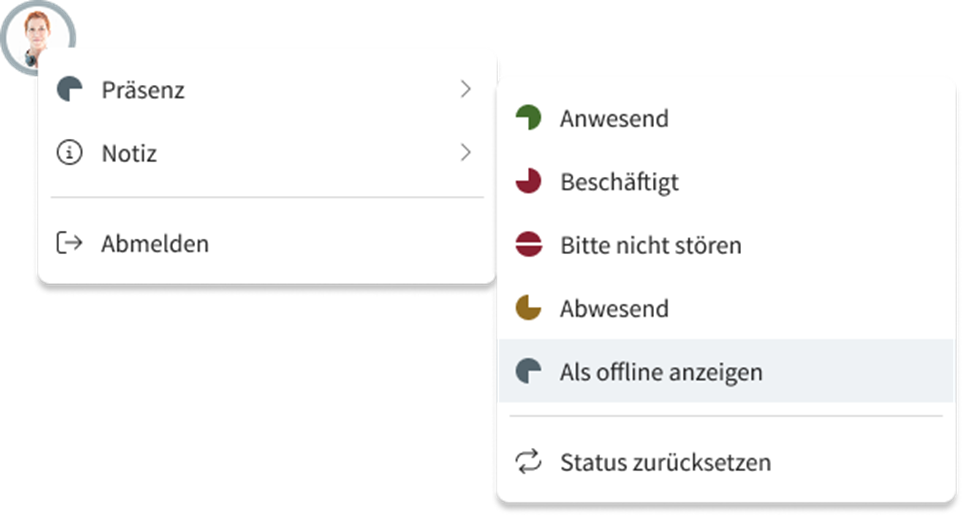
ProCall Web (Preview)
With ProCall Web you are no longer tied to a specific operating system - use ProCall directly in your browser or install the Progressive Web App (PWA) on your computer.
The software is available as a preview version. There are still limitations in terms of functionality and quality. We are continuously working on further development.
You can find more information here: https://support.estos.de/en/procall-enterprise/procall-app-fuer-web
Improvement and expansion of the collection group function for softphones in UCServer
The collective groups can now be used as an "agent group". Members of the group who use a softphone can log in and out of the group.
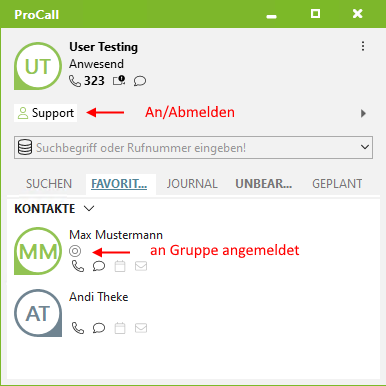
Depending on the status, incoming calls to the group are then delivered to the user or not.
Other group members with a softphone can see the status of the members in the favourites and in the monitor.
The status of the members is displayed in the UCServer administration:
"Logged in", "Logged out", "Logged in, but all ProCall clients terminated", "Logged out and all ProCall clients terminated".
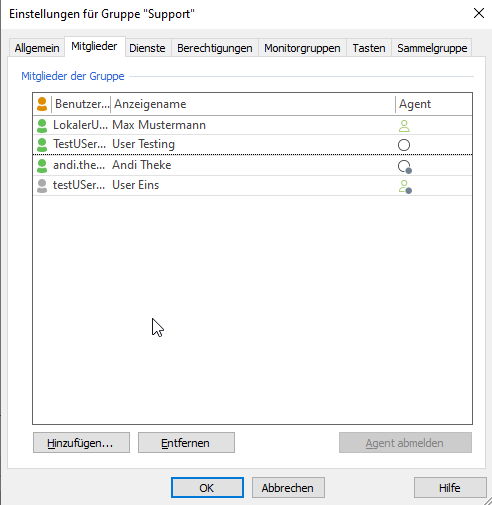
Time-controlled call forwarding for softphone for ProCall Desktop for Windows
For softphones, call forwarding can be set for unanswered calls (internal, external and general) after a selectable period of time (5 to 120 seconds). This allows calls to be automatically forwarded after the defined time has elapsed, for example. The new call forwarding can be set as an option in the line menu on ProCall Desktop for Windows. Call forwarding is carried out by the UCServer (i.e. not by the telephone system) on the SIP interface.
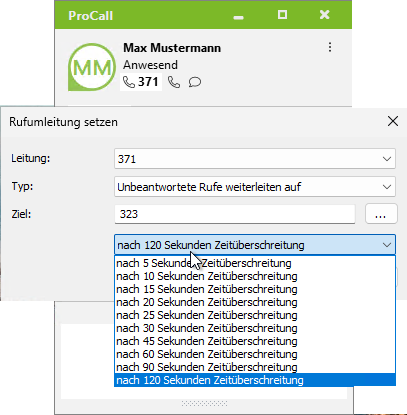
SIP line group: differentiated behaviour for logged off clients or DND
In the properties of the line group, the signalling behaviour can now be set separately when the ProCall client is logged off and when DND do not disturb is set.
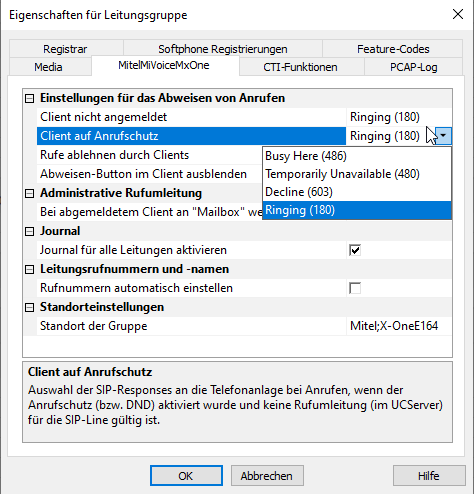
Tested headsets of EPOS
For ProCall Desktop for Windows, the following headsets from EPOS have been tested and included in the overview of compatible third-party products:
- Adapt 660 (Bluetooth ANC Headset w/ Dongle & Case)
- Adapt 560 II (Bluetooth ANC Headset w/ Dongle)
- Adapt 160T USB-C II (Stereo Teams certified)
- Adapt 160 USB II (Stereo UC optimized)
- Impact 1030 (Mono Bluetooth w/ Dongle)
- Impact 860 ANC (Duo headset, USB-C, ANC)
- Impact 760T (Duo headset, USB-C, Teams certified)
- SC 660 USB ML (Double-sided HS, USB)
- SP 30 + (Bluetooth Speakerphone w/ Dongle)
- Expand 80 (Bluetooth Speakerphone w/ Dongle)
Information on using EPOS Connect, SDK and call control can be found here:
ProCall Infinity - Release Notes 2510.0 Feature Update
The updated overview of supported products for ProCall Infinity can be found here: Supported third-party products
Bug fixes / improvements
- ProCall Infinity supports the Microsoft operating system Windows Server 2025. The same System requirements as for ProCall 8 Enterprise apply to ProCall Infinity in its current version.
ProCall Infinity supports Microsoft Exchange Server Subscription Edition (SE) and Microsoft Office 2024. The same Supported third-party products such as ProCall 8 Enterprise apply to ProCall Infinity in its current version.
- If there is a UCServer group, searching for an @ always returned the name of the group. This issue has been fixed.
- A problem with "no audio" in connection with the "internal pickup" has been fixed when the pickup process took a relatively long time. This could happen, for example, when a TAPI call was picked up by a softphone participant and the call took a relatively long time to reach the pickup destination.
- A newly configured SIP line was not sent to the client if the location was configured as "Automatic" in the line group. The issue has been resolved.
The server administration programme now better handles conflicting configuration processes relating to call forwarding. For example, if administrative call forwarding to the mailbox was activated for a user while the "Call forwarding" service was deactivated under "CTI functions", the setting was rejected without a message. In future, notes or questions will appear asking whether and how the setting should be applied.
- An "administrative call forwarding" setting in the SIP line group is now also applied to newly set up lines.
- Fixed: Occasionally, user permissions were not fully transferred to ProCall Desktop for Windows.
- Datenschutzerklärung "ProCall Windows und Mac" and "Datenschutzerklärung "ProCall App for Web / Microsoft Teams" have been updated, particularly with regard to the use of the open source software "Sentry" for automatically recording programme execution, errors and anonymous crash reports, which are stored and processed exclusively in European data centres.
Further information on which data is tracked and for what purposes it is analysed can be found here: What kind of data does estos collect and why?. - The files required for adding a certificate are provided again in the installation directory during installation.
- In an offline installation, the settings for the proxy configuration are no longer displayed.
- When converting the user database, the change must be confirmed again.
- Security when logging in to UCServer Administration has been increased. After several failed login attempts (default 3), the IP address is temporarily blocked. After further failed login attempts (default 10), the IP address is permanently blocked (until the next server restart).
Various memory leaks in MediaServer memory management have been fixed.
The total number of users is now displayed when installing or updating the UCServer.
Changed settings for the services are taken into account during an update. The start type of the UCServer is adopted.
- The restart of UCServer services has been technically optimised.
- ProCall Web no longer requires separate authorisation in UCServer.
- For softphone connection to an Auerswald PBX, the SIP profiles used when creating a new softphone line group have been updated. There is now one profile for COMtrexx and another profile for COMpact and COMmander variants.
- Connection to an Auerswald telephone system: If a call was accepted by an agent via a collective group, the agent was unable to successfully transfer this call to another internal subscriber after checking. The problem has been fixed.
- When connecting SIP lines to a Placetel PBX, the pickup is performed again without redirection.
- Fixed: When connected to Avaya IP Office, internal SIP-SIP pickup could no longer transfer the call back to where it was picked up.
- The SIP lines of a SIP trunk set up for Mitel OpenScape 4000 were not registered correctly when the UC server was restarted. The problem has been fixed.
- Fixed: Crash of ProCall Desktop for Windows when the Mitel OpenScape Business telephone system hung up immediately after a call from the other participant was put on hold.
- The time behaviour for call transfer actions by softphone users on an innovaphone telephone system has been improved. This means that calls on hold are no longer disconnected.
- The API for integration into Microsoft Teams has been updated and now supports (optionally) reading presences without user authorisation.
The problem with presence status getting stuck during integration for Microsoft Teams, which occurred due to unexpected connection losses from the UCServer to the Microsoft Graph API, has been fixed.
For the connection to Microsoft Teams on the UCServer, the Microsoft standard window is no longer opened when "user consent" is given; instead, the standard browser is opened.
- "Integration in Microsoft Teams" function in UCServer administration: With regard to app registration permissions, it is no longer necessary to assign user consent; instead, the app registration itself can now obtain the necessary permissions to read presences (getPresence) via service permissions. You can activate this feature by checking the "Use service permissions" box (recommended). See Change to app registration - User Consent - Service Permissions
- An authentication problem related to the Mitel MiVoice Border Gateway (MBG) has been fixed:
If the border gateway or telephone system offered multiple QoP (Quality of Protection) options, the response was incorrect and SIP registration did not work. - When registering with a Mitel Border Gateway, the value in the QoP header is sent without quotation marks.
- The "special authorizations" could not be set in the Active Directory extension for groups. The problem has been fixed.
- When assigning a line to a computer object, a message was displayed incorrectly. The issue has been resolved.
- Occasionally, lines were not fully initiated and were therefore not visible on the ProCall client. The issue has been resolved.
ProCall Desktop for Windows
Bug fixes / improvements
- For the groupware connection, improvements have been made to the ProCall workstation settings of ProCall Desktop for Windows to simplify the setup of Microsoft Outlook/Exchange and prevent misconfigurations.
Title bars/group headings in ProCall Monitor were not displayed completely when "View: Docked at edge" was selected.
- Chat rooms can now be reliably deleted. They will no longer appear in the chat list.
- Several bugs have been fixed that caused the initialisation and display of chats to fail.
- When creating a new group chat, the group picture can now be set correctly again.
- The context menu of a group chat in the communication list can be accessed again.
- A user's presence is displayed correctly again even after reconnecting to the application (e.g. when the computer goes into hibernation mode).
- The presence of all group members within a group chat is now displayed correctly at all times.
- The list of group members in a group chat can now be scrolled through completely again.
- Replying to a chat message with an image now works correctly.
- Chat with users who were once deactivated and then reactivated in Active Directory now works correctly again..
- The selection of additional emojis in chat is functioning as intended once again.
- The selected emojis will also be displayed as desired.
- The chat history is now displayed in full across all clients again.
- The width of the chat areas can now be adjusted more flexibly to suit the user's needs.
- Fixed several deadlocks and heap corruption issues.
- The issue where the old phone number was displayed in the search results when changing the phone number via the "ProCall Workplace Settings" has been resolved.
- Device recognition in ProCall Desktop for Windows in "Remote Desktop Mode" has been improved.
- The following issues for use in "Remote Desktop Mode" have been fixed:
Whereas previously only one controlling ProCall client could remotely control a single controlled ProCall client, it is now possible to log in multiple controlled ProCall clients. The controlling ProCall client automatically registers which controlled ProCall client is currently active. The controlling ProCall client is located in a virtual environment, such as a terminal server, while the controlled ProCall client runs on a physical PC with a headset. This allows the user, for example, to open their terminal server session from both their company PC and their home office PC, with the controlling ProCall client recognizing which PC is currently in active use.
- The controlled ProCall client no longer displays its conversation windows "topmost" in the foreground while it is being remotely controlled.
In the customer environment, the conversation window of the controlled ProCall client moved in front of the terminal server session window with the active, controlling ProCall, which could lead to operating errors. - If a ProCall client in remote control mode had a TAPI line and a softphone line, the selected default line could not be changed depending on the start sequence of the other client.
- The contact information in the chat has been comprehensively revised. Users can now view all stored information about a person from ProCall there. The widget enables quick access to availability as well as uncomplicated communication and collaboration across various channels – always with a click on the presence.
- A problem with synchronizing chat messages between all clients has been fixed.
- The close button is now visible in the image preview in the chat.
- Fixed: The profile-controlled Busy-on-Busy setting was not displayed in the system information of ProCall Desktop for Windows.
- The behaviour for the options "Presence status Do Not Disturb controls call protection" and "Call protection controls presence status Do Not Disturb" has been revised and improved in connection with Microsoft Teams.
Known issues and limitations
We publish known issues and limitations here: ProCall DataCenter known problems and limitations.